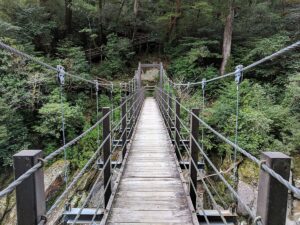Overview (history, characteristics, attractions)
Cape Muroto is a cape that juts out from the southeastern tip of Muroto City in eastern Kochi Prefecture, and is characterized by its majestic scenery, with rugged sea cliffs, oddly shaped rocks, and a wide horizon. Known since ancient times as a key navigation point, the cape area is registered as a Muroto Global Geopark (UNESCO Global Geopark) as a valuable site in terms of marine topography and geology. It is also home to historical sites (such as Mikuriya Cave) where Kobo Daishi (Kukai) is said to have trained, making it a tourist destination where natural scenery coexists with historical and religious attractions. The beauty of the sunrises and sunsets seen from the lighthouse and observation deck, and the power of the cliffs created by the rough waves, attract visitors.
Highlights
- Cape Muroto Lighthouse: A symbol of the cape. You can get a panoramic view of the Pacific Ocean from the exterior and surrounding area (visiting the interior is subject to restrictions depending on the time and circumstances).
- Mikurodo Cave and Floating Island (a place associated with Kukai): Caves and rocky areas where Kukai is said to have preached and practiced. A spot where you can feel faith and history.
- Geosites (unusual rock formations and sea cliffs)The area is dotted with landscapes that give a sense of the earth's movements, such as uplifted strata, steep cliffs caused by sea erosion, and columnar and strangely shaped rock formations.
- Observation trails and observation decks: There are walking paths and observation spots around the cape, where you can enjoy everything from a peaceful stroll to photography.
- Seafood and local delicacies: You can enjoy fresh seafood and local cuisine at roadside stations and surrounding facilities.
Access (nearest station, transportation, etc.)
- car: From Kochi City, head east on National Route 55. The journey time will vary depending on traffic, but it will take approximately 1.5 to 2 hours. There are several parking lots near the cape.
- Public transportation (train + bus)The nearest railhead is the Tosa Kuroshio Railway's Nahari direction or Kochi Station. From Nahari Station or Kochi Station, take a local bus bound for Muroto to Cape Muroto. Buses run infrequently, so please check the timetable in advance. (Estimated travel time: about 40-60 minutes by bus from Nahari Station, 1.5-2 hours from Kochi Station depending on the route.)
- Express bus toursDepending on the season, express buses and sightseeing bus tours operate between Kochi and Muroto. Joining a tour makes travelling easy.
Estimated stay (estimated time required)
- Short tour (viewing only): Approximately 1-2 hours (walking around the lighthouse and major observation spots)
- Leisurely sightseeing: Half a day to a full day (visiting geosites, visiting Mikuriya Cave, eating at roadside stations)
- If you include walking around the area, hot springs, and lodging: 2 days or more
Nearby spots
- Muroto World Geopark Center (geo explanations and exhibits)
- Historical sites and worship sites around the Mikuriya Cave
- Roadside stations (facilities selling local specialties and seafood)
- The surrounding coastline, small beaches, and fishing ports (where you can enjoy local seafood depending on the season)
- Hot spring facilities and accommodations in Muroto City (we recommend staying at an inn with an ocean view)
Things to be aware of (crowds, manners, seasonal precautions, etc.)
- Weather and clothing:The cape is windy and the weather can change suddenly. The wind can feel cold, especially from early spring to winter, so be sure to take measures to protect yourself from the wind and cold. The sun can be strong even in summer, so be sure to bring a hat and sunscreen.
- Dangers at sea and on rocky shores: On days with high waves or at high tide, the coast and rocky areas can be extremely dangerous. Never enter or go near the water's edge. Be careful of falling rocks and slippery ground.
- Transportation methods and number of trains: The number of buses is limited, so be sure to check the return trip time in advance. Renting a car or your own car is more convenient.
- Nature Conservation and Manners: Always take your trash with you and avoid damaging vegetation or the terrain. Please be quiet in religious and historical sites.
- congestion: Roads and parking lots tend to be crowded during peak seasons (long weekends and summer vacation). Early mornings and evenings tend to be quieter, but the number of tourists fluctuates depending on the tourist season.
Cape Muroto is a place where the power of nature and the scent of history coexist. Please enjoy the views, strolls, and local cuisine at your leisure, while taking safety precautions. If necessary, please let us know so we can provide you with more detailed and up-to-date information, such as access timetables and accommodation information in the area.


